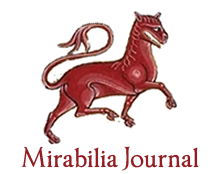Writing, legitimacy and memory: slogans and badges of Alfonso V the Magnanimous (1416-1458)
Gema Belia CAPILLA ALEDÓN
Original title: Escritura, legitimidad y memoria: lemas y divisas de Alfonso V el Magnánimo (1416-1458)
Published in
Alfonso V the Magnanimous, King of Aragon (1416-1458), due to his linking to the Neapolitan throne and his role in the European policy of the Quattrocento, built a speech of his image to represent himself to his contemporaries and to the posterity. His purpose was to prove his legitimacy as heir to Naples, to appear to his contemporaries as the new princeps sponsored by the Italian Humanism and to remain in memory like a virtuous Caesar. This speech was composed of numerous and varied pieces ranging from the field of numismatics to Sigillography passing through the tilework or epigraphy, to name a few, and among which stand out from those containing motes and symbols denoting some specific qualities of the sovereign. Therefore, the aim of this article is to analyze the use made by the king of this slogans and badges and to restore their chronological and symbolic place in the political and cultural program designed by the Magnanimous.
“A donzela que não podia ouvir falar de foder” e “Da mulher a quem arrancaram os colhões”: dois fabliaux e as questões do corpo e da condição feminina na Idade Média (sécs. XIII-XIV)
Ricardo da Costa and Nayhara Sepulcri
Published in The educacion and secular culture in the Middle Ages
Analysis of two fabliaux and the status of women in the Middle Ages.
“Checkmate to the time, the forms and the place…”. Meister Eckhart between flowing of time and stillness of Eternity
Matteo RASCHIETTI
Original title: “Xeque-mate ao tempo, às formas e ao lugar...”. Mestre Eckhart entre o fluir do tempo e o remanso da Eternidade
Published in The Time and the Eternity in the Ancient and Medieval World
The conception of time in Eckhart’s reflection is a fundamental point that joins the thought of German Dominican: the metaphysic model of development of being overcomes the concepts of time and eternity, leading plurality into One, the duplex esse into unum esse, the temporal into timeless. The illustration of the main features of this rational path, here, is done starting from the poem Granum sinapis, which condenses the main themes of philosophicaltheological speculation of Thüringen, among of that there’s the issue of time.
“In the Syrian Taste”: Crusader churches in the Latin East as architectural expressions of orthodoxy
Susan BALDERSTONE
Original title: “Ao sabor sírio”: as igrejas dos cruzados no Oriente latino como expressões da arquitetura ortodoxa
Published in The Middle Ages and the Crusades
This paper explores how the architectural expression of orthodoxy in the Eastern churches was transferred to Europe before the Crusades and then reinforced through the Crusaders’ adoption of the triple-apsed east end “in the Syrian Taste”2 in the Holy Land. Previously, I have shown how it can be deduced from the archaeological remains of churches from the 4th-6th C that early church architecture was influenced by the theological ideas of the period3. It is proposed that the Eastern orthodox approach to church architecture as adopted by the Crusaders paralleled the evolution of medieval theology in Europe and can be seen as its legitimate expression.
“Thy Kingdom come”: The Legitimation of the Medieval Court Through Image of the Heavenly Court
Jó KLANOVICZ, Icles RODRIGUES and Rodrigo Prates de ANDRADE
Original title: “Venha a nós o Vosso reino”: a legitimação da Corte Medieval através da imagem da Corte Celestial
Published in Aristocracy and nobility in the Ancient and Medieval World
This article studies the medieval court by a perspective of a historiographical readout of the political theology. The idea of an instrument of legitimation of the royal power based in the heavenly court and that mirrored in the earthly court. This conception is very present in the medieval iconography, that will be used in this analysis.
“With iron, fire and argumentation”: Crusade, Conversion and the Doctrine of the Two Swords in the Ramon Llull's Philosophy
Ricardo da COSTA and Tatyana Nunes LEMOS
Original title: “Com ferro, fogo e argumentação”: Cruzada, Conversão e a Teoria dos Dois Gládios na filosofia de Ramon Llull
Published in The Middle Ages and the Crusades
Analysis of the Crusade’s propose, conversion and the Theory of Two Swords in the philosophy of conversion of Ramon Llull, based on the poems Lo desconhort (1295), Del consili (1311) and the works Llibre de contemplació en Déu (c.1271-1273), Liber de passagio (1292), Arbor scientiae (1295-1296), Liber de fine (1305), Disputatio Petri clerici et Raimundi phantastici (1311) and Liber de ciuitate mundi (1314).


















































































